|
It’s perhaps a tad ironic that the Eureka release that I was most looking forward to in May 2021 was the only one I wasn’t sent a review disc for. Then again, this is probably down to the fact that in the past couple of years we’ve failed to cover several of the label’s other martial arts titles. I should note that this was not intentional and more the result of bad luck and bad timing. I’m a huge fan of Jackie Chan’s early work and can really offer no excuses for not prioritising Eureka’s 2019 Blu-ray releases of Project A & Project A Part II and Wheels on Meals or the recent Lucky Stars collection, at least beyond the usual limitations on my time imposed by my day job and colourful medical issues.
Despite my love of early Chan movies, I have an altogether different relationship with titles like writer, director and leading man Jimmy Wang Yu’s One Armed Boxer. Made in 1971 and released worldwide in 1973, this was part of the first wave of martial arts movies to go international, movies that I lied about my age to somehow bluff my way into cinemas to see when I was legally far too young to do so. If you want the whole story of how this came about and how I fell in love with these films, you’ll find it in the opening paragraph of my review of the 2003 Thai martial arts actioner, Ong-Bak. Needless to say, I watched a lot of these films and have specific memories of many of them, but despite knowing full well that One Armed Boxer was one of the films I saw, when this Blu-ray was announced I was able to recall almost nothing about it, save for the fact that the lead player wasn’t born with one arm but lost it somewhere in the film and had to learn a new fighting style to take an appropriate revenge on someone for something. As you can probably gather from that fuzzy recollection, it’s been a very long time since I first saw it and I was keen to see if watching it all this years later would reawaken any buried memories. I was thus just a little disappointed when the review disc didn’t arrive, so bought the retail version instead with the original intention of just posting a few brief comments about it on Twitter. But watching it really did take me back to my teenage years, when I dressed above my age and tried to affect a deeper voice to convince the disinterested woman at the box office that I was indeed old enough to see this X certificate movie. And as it was with so many titles in this then-new but fast-growing subgenre of the action movie, One Armed Boxer proved to be a stronger and more entertaining film than I secretly feared that it would turn out to be.
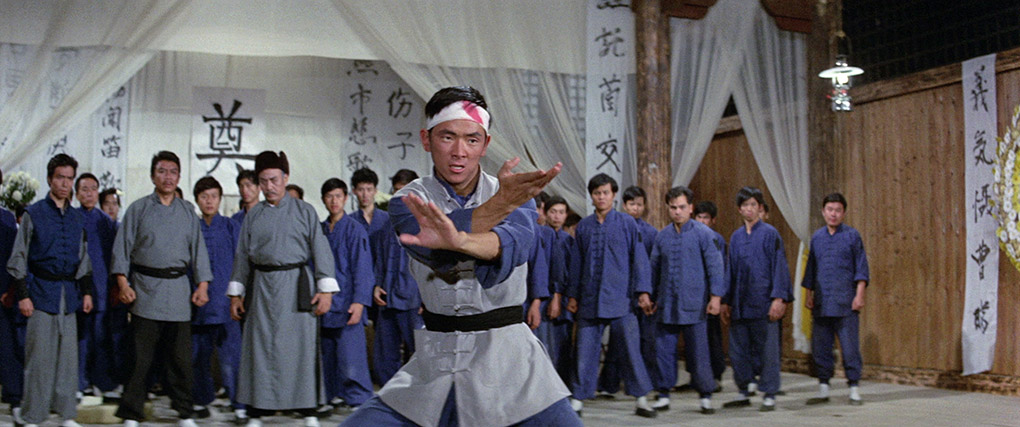
If you’re new to first-wave martial arts movies, it’s worth knowing up front that they’re not big on complex plotting and nuanced characters. Most of these films adhere to a formula, one in which the hero is as a good-hearted fighter who is often aligned to a Chinese martial arts school with an honourable master. When that fighter suffers a humiliating or crippling defeat or is traumatised by the sight of an unspeakable act by evil members of a rival school, he retrains and develops new skills that he then uses to take revenge on behalf of himself, his master, his school, and decent people everywhere. Oh yes, and the wicked students of the rival school will often be foreign, usually Japanese, a traditional (and given the actions of the Japanese in China in WW2, frankly understandable) enemy in post-war Chinese action cinema. And so it is with One-Armed Boxer, and then some, but I’ll get to that in a minute.
Here the noble hero is Yu Tien Lung (played by writer-director Jimmy Wang Yu), a star pupil at the Ching Te martial arts school, who is dining with three of his fellow students at a local tea house when a group of Hook Gang members march in and start beating up a patron when he refuses to hand over his prized caged bird (it makes more sense when you see it). Yu and his friends intervene, and despite being soundly outnumbered, they hold their own and Yu gives the opposing group’s leader, Ma Mu Tao (Chun Lei), a bit of a pasting. The bloodied Ma then dares Yu to meet him for a showdown in a nearby valley, a challenge that Yu defiantly accepts before leaping in the air to deliver a mother of a drop kick. Freeze frame, cue titles and title music and… what the hell? Unless my beleaguered ears deceive me, isn’t that the main theme from the previous year’s blaxploitation classic, Shaft? Was Isaac Hayes even aware of this? Probably not. Another common trait of first wave martial arts films was the borrowing of music from popular western movies of the period. It’s always a bit jarring if you know the originals, but Hayes’ iconic theme has since become so instantly recognisable that its appearance here comes as a genuine jolt. It won’t be the last time to hear it, either.
The two sides are roughly equal in numbers in the valley battle, but Yu and his comrades once again come out on top (for the record, by then we’re only seven minutes into the film and have already had two substantial fights). Knowing that their teacher, Han Tui (Ma Kei), will disapprove of what he regards as a misuse of their martial arts training, Yu takes the full blame and is punished for his actions. Unsurprisingly, the Hook Gang members are not so honourable, claiming to their boss, local criminal kingpin Chao Liu (Tien Yeh), that they were attacked without provocation. Intriguingly, when Chao learns that they fought against the talented Yu, he’s not surprised that they lost. Ma then claims that Yu said he’d even teach Chao a lesson, and that tips the balance. “Bring my weapon!” Chao angrily barks. “Assemble the men. I’ll go and redeem our honour.” This he attempts to do by marching into the Ching Te school with a gaggle of armed goons, where he is politely greeted by Han, who assures him that Yu has been appropriately punished and offers his apology. Chao cheerfully accepts this and the two agree to let bygones be bygones and… oh, who am I kidding? What Chao does is demand that Han hand Yu over, and when Han refuses, Chao attacks him and a fight breaks out between the two groups, one that Chao ultimately loses after he attacks Han with a concealed blade, the dishonourable git. Before being helped away by his men, Chao promises vengeance on Han. “Only one of us lives,” he pledges. “I will never lose to you.” Hate to tell you, matey, but you just did.
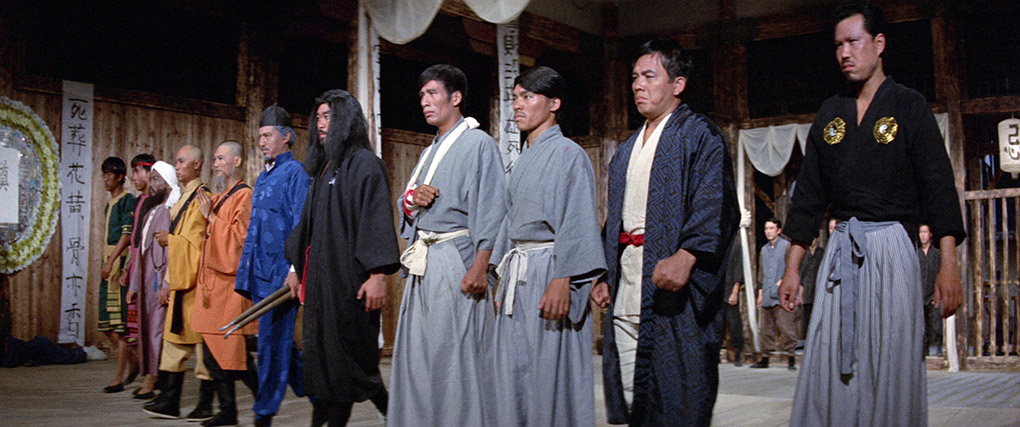
Chao clearly needs new fighters, ones with sharper skills and little in the way of pesky morality. Now where in all of China do you think he could find such men? Yep, it’s here that the expected foreign bad guys make their appearance. It should surprise no-one that the first two we meet are Japanese in the shape of the very Chinese-named Pan Tien-Ching (Wang Yung-Sheng) and Chang Ku Chuan (Hung Tsai), who are given the more authentically Japanese names of Hasegawa-san and Sakata-san by the English subtitles. More unexpectedly, they’re joined by an unusually varied collection of fighters from different countries, each of them masters of a particular fighting style. There’s Japanese Judo expert Kao Chiao (Tung Chiao Wu), a humourless and stern-face brute who’s been renamed Koji-san by the subtitles. There’s Korean taekwondo master Chin Chi Yung (Shan Mao), who’s renamed Kim Jim Yong in the subs and who demonstrates his toughness by biting the head of a bottle of booze and guzzling its contents. Up next are Nai Chi (Kuan Hung) and Mi Sao (Blackie Ko) from Thailand, who have to be two of the first exponents of the Muay Thai fighting style in eastern action cinema. Possibly the most confusing of the bunch is Mura Singh (a blackface Chun Lin Pan), a skilled exponent of yoga from India. I have to admit that I wasn’t aware that yoga was ever a fighting style, and research has failed to turn up any evidence to suggest that it was. Certainly nothing is clarified by Mura’s demonstration of his skills, which involves him smilingly pulling out a dagger and stabbing himself in the chest without inflicting any sort of injury. When he does get to fight, it gets even weirder. Late to the party are two athletic Tibetan Lamas, Cho Fu (Su Chen Ping) and Cho Lo (Yi-Kuei Chang), but the real star of the show is Hasegawa and Sakata’s master, karate expert Erh Ku Da Leung (Lung Fei) from Okinawa, and if you’ve been wondering if the film is going to have a cartoon bad guy, then look no further. Leung dresses exclusively in dark clothing, has long straggly hair, a beard and some of the thickest eyebrows I’ve ever seen. And he has fangs! Seriously, this guy is halfway to becoming a werewolf.
That this newly assembled squad of deadly fighters will eventually wreak havoc in the Ching Te school is inevitable, but not before they have bust up the school’s businesses and beaten up their workers. Hanging over all of this, of course, is the promise of the title – as I recalled, there are no single-armed boxers here, so it’s clear that somebody will lose one of their limbs during the course of all this fighting, and genre convention makes Yu the prime candidate. Rather neatly, Wang the writer and director appears to be aware that we know this is coming and elects to tease us with a fight in which Yu battles the Hook Gang in a mill in which gigantic metal cogs are turning. I, for one, kept waiting for the moment when he would accidentally get his arm caught in the machinery or have thrust in there by one of his opponents. What I didn’t expect was that he would survive this fight intact, then lose the limb to a single forceful blow delivered by the karate werewolf.
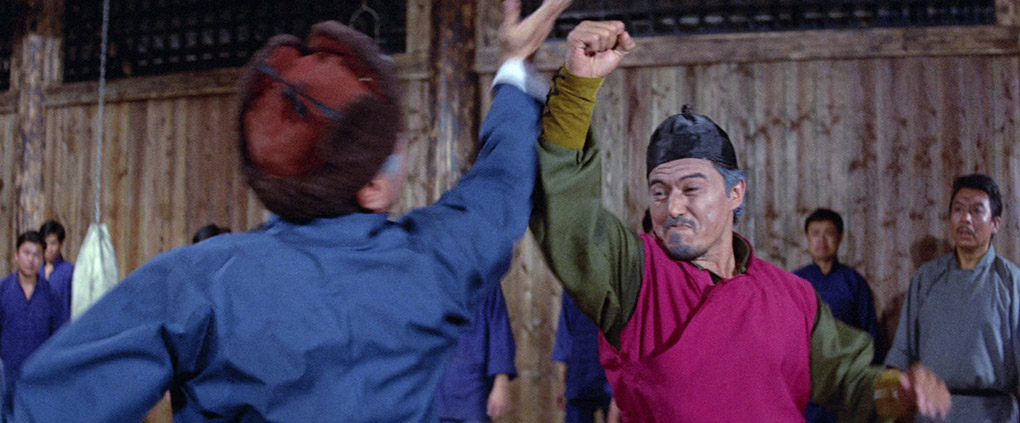
The villains and the by-the-book plot development may be easy to affectionately mock, but the raison d’être of any first wave martial arts movie always lay in the quality and quantity of its fight scenes, and on that score One Armed Boxer meets and even surpasses expectations. There are a couple of fighters with slightly iffy combat skills, but they’re not on screen for long and for the most part the battles are smartly choreographed and energetically performed (serious props here to action director and stunt co-ordinator Chih Hua Chen). And there is a lot of martial arts combat here – I did a rough check and almost half of the running time is devoted to fight scenes, including a 12 minute final showdown. This generosity of action is given a further boost by Wang’s direction, which varies the manner in which the fights are filmed, employing everything from long-held wides that really showcase the skills of the performers to more rapidly cuts sequences, energetic handheld camerawork, extreme wides in which figures are dwarfed by the landscape, and a carefully rationed and effective use of slow-motion. Even in the non-action sequences, Wang and cinematographer Mou Shen Ku make expressive use of camera movement and the scope frame, and together with editors Chen Hung Min and Chang Yao Chung they keep the story moving at a considerable lick. Formulaic it may be in some of its characters and plotting, but One Armed Boxer is still a seriously well-made film.
Having so much of the running time given over to action could so easily have made the combat feel repetitive to the point where you find yourself muttering, “not another fight scene,” but Wang’s creative coverage and the use of a variety of martial arts styles ensures that it never gets even remotely stale. Just occasionally, the combat flirts with fantasy, notably in Singh’s stacatto stop-motion hand-walk around his opponent and Cho Lo’s ability to inflate his chest into an almost impenetrable life jacket. For the most part, however, the fights have a thrillingly tough and immediate feel, being choreographed and performed to look less like spectacular showcase battles than how such skilled martial arts practitioners might actually fight each other if their lives depended on it. Being an old-school work, every hit and kick is accompanied by a loudly exaggerated smack, slap or wallop, and every rapid movement of an arm or leg by a cartoon whoosh, but as someone who grew up on these movies and these gloriously over-the-top sound effects, I wouldn’t have it any other way.
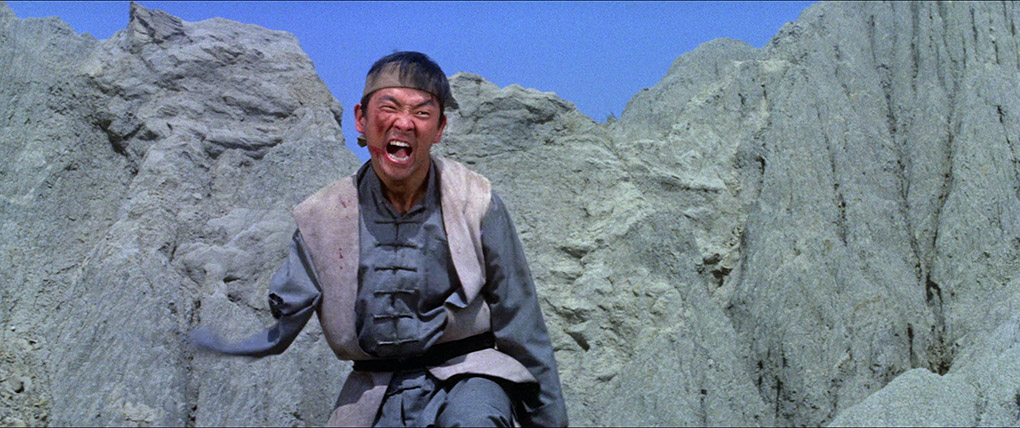
History has been a little unfair to Jimmy Wang Yu, a martial arts movie pioneer whose massive popularity on his home turf was ultimately eclipsed on the international scene by the arrival of a certain Bruce Lee, on whom all eyes and press was subsequently focussed. One Armed Boxer showcases Wang both as a director and performer at his finest and is rightly regarded as one of the highlights of that crucial first wave of martial arts actioners. Formulaic some of its characters and plotting may be, but the same goes for just about every old-school martial art movie, and a good few more modern examples too. In common with its subgenre brethren, it’s all about the action, and in the quality, variety, performance and presentation of its multitude of fight sequences, One Armed Boxer is an absolute belter.
Oh, how great it is to see a martial arts movie from the early 1970s looking as polished-up as it does here. For those who do not know, few if any of these films were preserved with an eye on any future interest, as the makers and distributors genuinely believed in these pre-VHS days that the films would have no life after their initial release. It’s this that accounts for the wretched condition of some of the early DVD releases of many martial arts titles of the period, where the scope picture would often be cropped to 4:3 and the image plastered with dust and damage, fuzzy in its detail, and have washed-out colour and contrast. A prime example that I have a review for is 55th Chamber’s 2006 DVD release of My Kung Fu 12 Kicks, the memory of which still sends shivers down my spine. The 2.35:1 transfer of One Armed Boxer on Eureka’s Blu-ray was sourced from the original film elements and is the polar opposite of this, an often lovely restoration with gorgeous contrast and colour and an impressive level of detail. There are a few blink-and-you’ll-miss-them instances of frame damage, and the opening credits, which would likely have to have been sourced from a composited print rather than a negative, are a bit rough, but elsewhere the results are top-notch with precious few dust spots, no edge enhancement and a fine level of film grain throughout.
The original Mandarin soundtrack is available in Linear PCM 2.0 mono and tends to show its age more readily than the image, with a noticeably narrower dynamic range than you’ll find in the equivalent Hollywood films of the period, something especially evident in the dialogue and music, though the contact wallops and slaps of combat are all rendered at an impactful volume.
Also included is and in Linear PCM 2.0 is an alternative Mandarin mono soundtrack, and while I’ve not made a side-by-side comparison to check all the differences, first impressions suggest that they are primarily confined to the music score, with the opening credits no longer featuring the main theme from Shaft, but something with a slightly spaghetti western twang.
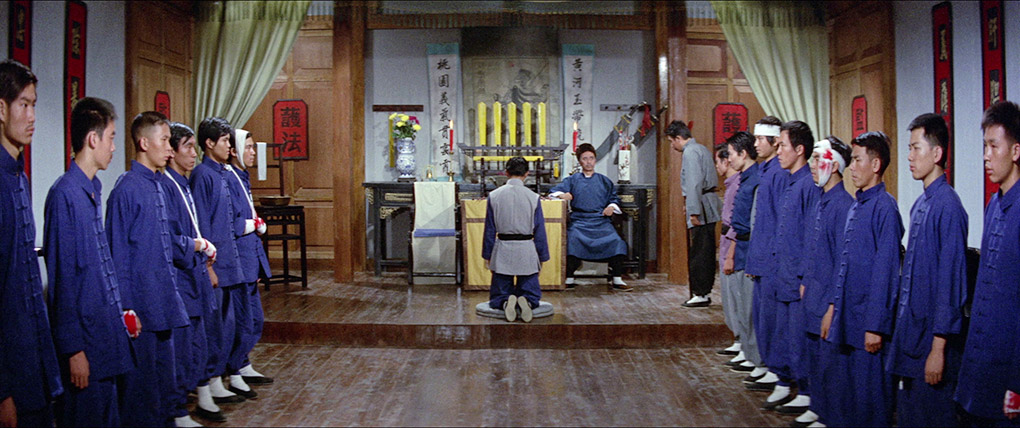
Finally, we have the Linear PCM 2.0 mono English dub, which is how I first saw the film back in the 1970s when such dubbing was standard on Hong Kong martial arts movies. I was gearing up to start wincing as soon as I switched this on, but as these things go, it’s not that bad. Obviously, the Mandarin tracks are far more authentic – the actors are clearly speaking the language we hear – and the dialogue on the English track has been altered to match the timing of the delivery and is obviously not being spoken by any of the actors (Wang fares the worst here), but if you struggle with subtitles, the English language track will at least not offend, and for those of us who grew up on these films it has an oddly comforting nostalgia value.
Optional English subtitles kick on by default on the Mandarin tracks but can also be activated manually to accompany the English dub if you want to observe the sometimes-colourful ways in which it differs from the Mandarin original.
Audio commentary with Asian Film Expert Frank Djeng
Frank Djeng certainly knows his martial arts movies, and like me has a particular fondness for first wave films and their exaggerated sound effects and has plenty to say about what he regards as one of the best of the old-school kung-fu films. No arguments here. He admits up front that little is known about most of the Taiwanese cast members, but does cover the life and career of writer-director-star Jimmy Wang Yu. He provides some useful translations of signs and names, as well as cultural information that clarifies points that might otherwise confuse western viewers (why people took caged birds into tea houses, for example), as well as confirming that the various fighting styles and pre-fight rituals are, for the most part, accurately performed. We get comments on the ‘borrowed’ music, the action, the characters, the American retitling to The Chinese Professionals, and he even relates a personal story to back up his claim about the effectiveness of acupuncture. He’s clearly had more luck with it than me. A splendid commentary from which I learned a lot.
Alternate English Credits (1:57)
Sourced from an international print of the film, this, I’m guessing, is the version I saw at the cinema. It has the spaghetti western music from the alternate Mandarin soundtrack.
Stills Galleries
This is subdivided into three categories: Production Stills has 22 screens of promotional photos of varying sharpness and colour (some are monochrome); Artworkhas 10 screens ofinternational posters (the original release Chinese one is the best); Lobby Cards has a weighty 31 screens of artificially coloured front-of-house stills, some of which also have a textual accompaniment.

Original Hong Kong Trailer (4:11)
A somewhat ramshackle affair with lots of hits, kicks and yelling and some entertainingly bold statements made about the film’s content and style, including the slightly suspect claim that it is “a film of documentary realism,” while wildly exaggerated punch and kick sounds explode on the soundtrack.
The Chinese Professionals Promo (0:55)
“Combine The Dirty Dozen with The Magnificent Seven and you have The Chinese Professionals,” claims the delusional narrator at the start of this no-nonsense trailer that trades appropriately on the fights and the variety of villains.
Booklet
A typically well produced but just slightly anaemic booklet by Eureka’s standards, something signalled up front by the use of a larger than usual typeface. Leading the way is an essay by film critic and historian James Oliver, who looks at Jimmy Wang Yu’s early film career and the importance of his 1970 The Chinese Boxer before offering an engaging appreciation of One Armed Boxer. Following this is a reproduction of the entry for the film from the exhaustingly titled but impressively comprehensive The Ultimate Guide to Martial Arts Movies of the 1970s: 500+ Films Loaded with Action, Weapons and Warriors by Dr. Craig D. Reid. Viewing notes and credits aside, that’s about it.
Poster
One real plus of getting my hands on the commercial release instead of a review disc is that I also get the packaging and physical extras. Included here is an attractive cardboard slipcase and a double-sided fold-out poster for the film, on one side of which is the original Chinese poster, while on the other is new artwork by Darren Wheeling. This is only included with the first 2000 copies.
Revisiting films that I was taken by in my youth after a gap of many years is fraught with the potential for extreme disappointment, as what thrilled me in my mid-teens can often look very different now that I’m older than God. It’s thus been a bit of a thrill to discover that so many of the martial arts films I fell in love with as a young man are still so good and play so well. Having been bowled over by how entertaining titles like Hapkido, Fist of Fury and King Boxer still are, I was more than a little delighted when One Armed Boxer proved to be their equal. I can’t speak for those who’ve yet to be seduced by the very specific delights of old-school Hong Kong martial arts cinema, but if you’re a fan then you should consider this Blu-ray an essential purchase. The film is still an action-packed blast, the transfer is impressive, Frank Djeng’s commentary is packed with interesting information about the film, and you even get a double-sided poster if you get one of the first 2,000 copies. Lovely stuff.
|